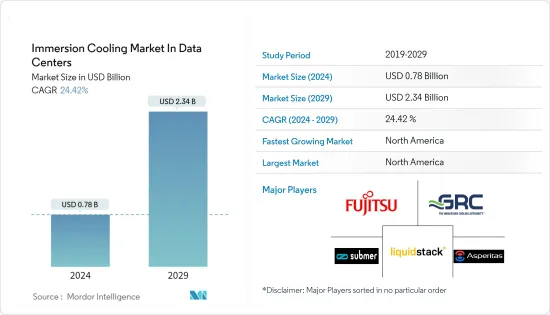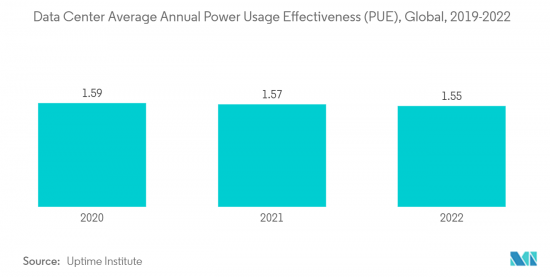PUBLISHER: Mordor Intelligence | PRODUCT CODE: 1404499

PUBLISHER: Mordor Intelligence | PRODUCT CODE: 1404499
Immersion Cooling in Data Centers - Market Share Analysis, Industry Trends & Statistics, Growth Forecasts 2024 - 2029

The Immersion Cooling Market in Data Centers Industry is expected to grow from USD 0.78 billion in 2024 to USD 2.34 billion by 2029, at a CAGR of 24.42% during the forecast period (2024-2029).
Dealing with high-density power consumption drives the market, as many industry estimates put cooling costs at around 40% of the data center's energy consumption. The immersion cooling is able to reduce the data center's energy usage by over 60%, with some systems stating it could be as much as a 95% reduction. For many data centers, this provides millions of dollars in savings annually.
The recent surge in data center construction activities, majorly targeted toward serving high-traffic zones with minimum latency, forced data center operators to expand beyond a suitable environment into complex urban facilities. This increased the demand for server cooling technology that involves the environmental and space constraints that traditional air and liquid cooling practices pose. The increasing need for solutions may significantly reduce the data center's physical footprint and simultaneously accommodate high-density operations, bolstering the demand for immersion cooling.
Growing developments in IT infrastructure in emerging economies, such as India, China, and other countries, is likely to boost the demand for data centers positively. The demand for data centers is likely to increase due to the adoption of the cloud model, which has cost and operational benefits for the IT industry. According to a study by NTT Ltd, over half of the respondents (52%) mentioned that the cloud would have the most transformational impact on their organization's business operations. Hence, the demand for the cooling of data centers is expected to increase, leading to the implementation of liquid cooling methods based on end-user preferences.
The growing use of Big Data, AI, to name a few, has led organizations to face a data-crunch challenge. For instance, the rising demand for cognitive capabilities in the United States led IBM Corporation to build four new cloud data centers. This is likely to encourage the utilization of cooling technologies in these data centers.
Immersion cooling is one of the most effective ways to cool data centers through dielectric liquids. High investment with more significant technological CAPEX has been the only restraint hindering the market's growth.
The outbreak of the COVID-19 pandemic posed additional stress on multiple economies across various sectors. This shifted the focus toward a digital economy. The new load on data centers is serious. More employees are working from home, increasing video calls and VPN usage. Allied health professionals have ramped up the use of telehealth applications to treat patients. China's top cloud computing provider, Alibaba Cloud, invests billions in building next-generation data centers to support digital transformation needs in a "post-pandemic world."
Data Center Immersion Cooling Market Trends
Dealing with High-density Power Consumption Driving the Market
- The GPU-rich system is based on a 2U ThinkSystem SR670 rack server, which includes up to four double-width GPUs per server. A small half-rack 24U system includes up to four Lenovo servers and uses less than 5 kW. At the same time, the medium-sized version includes up to 16 of the servers in full-sized 46 kW racks and can be scaled up by including as many of those racks as needed. Both systems are monitored with Schneider's EcoStruxure IT.
- On the energy absorption front, liquid immersion cooling submerges all electrical components in a dialectic liquid, thus reducing the energy footprint of IT alone by between 10% and 45%, as per Asperitas, a Dutch startup selling plug-and-play liquid immersion cooling modules to data centers. It further highlighted that suitable dielectric liquids absorb approximately 1,500 times more heat energy than air with the same volumes and temperatures.
- As organizations are observed to be adding blade servers and storage devices to improve their performance, data centers are demanding more electricity and producing high heat. On average, the heat dissipation exceeds the 30 kW-50 kW/server rack. Thus, allied investments in cooling and heat management solutions for efficient heat and equipment management are increasing globally. In March last year, AMAX's HPC and AI Solutions Group announced a new 2U 4-Node density optimized server, ServMaxAE-2484L, for single-phase liquid immersion cooling.
- The server is recognized to improve Power Usage Effectiveness (PUE) by reducing server power usage by up to 20% amid the highest CPU compute density in its form factor. The 2U 4-Node density optimized server focuses on solving constraints such as location, the availability and cost of power, and the handling of increasingly demanding computing requirements, such as HPC and AI workloads.
- According to a survey conducted by Uptime Institute, at the largest data center, IT and data center management reported an annual power use effectiveness (PUE) ratio of 1.55. Data center operators strive to achieve a PUE ratio as near to one as feasible, with many of the newest data centers from hyperscale and colocation providers delivering higher efficiency than those using older technology.

North America is Expected to Register the Largest Market
- North America is an early adopter of newer technologies. Datacenter investors are increasingly investing in liquid immersion and direct-to-chip cooling solutions. The importance of edge data centers has been aided by the emergence of 5G networks worldwide, and the United States is among the earliest adopters of the technology. Many operators in the United States, such as EdgePresence, EdgeMicro, and American Towers, started investing in these centers.
- Moreover, the mobile data traffic in the United States increased considerably over the years, from 21.49 exabytes (EB) 2028 of data traffic in 2017 to 6.7 EB exabytes per month of data traffic by this year, as reported by Cisco Systems. According to Ericsson, this data traffic is expected to triple by 2030. Thus, the distributed cloud that may secure the low latency and high bandwidth required to connect such scale easily is coming into action.
- Due to multiple factors, energy use in US data centers is expected to grow slightly, increasing by more than 4% from 2014 to last year, according to the Energy Technology Area. Based on current trend estimates, the US data centers were projected to consume approximately 1.9 gigawatts in 2022.
- The United States is witnessing massive growth in internet usage by people and businesses. The country is the largest market in data center operations, and it continues to grow due to the higher data consumption by end-users. The growing popularity of the IoT is a significant driver for the US hyper-scale data center market, leading to additional facilities supporting exabytes of data generated by business users and consumers.
- Multiple US-based companies, like Microsoft, are researching immersion cooling deployment in data centers. The production environment deployment of two-phase immersion cooling is the next step in Microsoft's long-term plan to keep up with demand for faster, more robust data center computers when reliable advances in air-cooled computer chip technology considerably slowed. Microsoft researched liquid immersion as a cooling solution for several high-performance computing applications, such as AI. The investigation revealed that two-phase immersion cooling reduced power consumption for any given server by 5% to 15%.
Data Center Immersion Cooling Industry Overview
The degree of competition in the market studied is high and is expected to increase over the forecast period. Players in the market are adopting strategies such as partnerships and acquisitions to enhance their product offerings and gain sustainable competitive advantage. Fujitsu Limited, Green Revolution Cooling Inc., Submer Technologies SL, Liquid Stack Inc., and Asperitas Company are some of the key market players.
In September 2022, Dow announced DOWSIL Immersion Cooling Technology, which is an optimized and sustainable solution for cooling hyperscale cloud and enterprise data centers. DOWSIL Immersion Cooling Technology offers a revolutionary approach to thermal management and sustainability for fast-growing data centers in an era of high-speed, high-volume communications.
In February 2022, InfraPrime and Iceotope Technology Ltd entered a partnership to eliminate and reduce water consumption for Net Zero PowerShell Sites throughout the data center life cycle. It would help leverage and boost the full potential of circular businesses for sustainable economic growth and a resilient future.
Additional Benefits:
- The market estimate (ME) sheet in Excel format
- 3 months of analyst support
TABLE OF CONTENTS
1 INTRODUCTION
- 1.1 Study Assumptions and Market Definition
- 1.2 Scope of the Study
2 RESEARCH METHODOLOGY
3 EXECUTIVE SUMMARY
4 MARKET INSIGHTS
- 4.1 Market Overview
- 4.2 Industry Attractiveness - Porter's Five Forces Analysis
- 4.2.1 Bargaining Power of Suppliers
- 4.2.2 Bargaining Power of Buyers
- 4.2.3 Threat of New Entrants
- 4.2.4 Degree of Competition
- 4.2.5 Threat of Substitute Products
- 4.3 Assessment of the Impact of COVID-19 on the Industry
- 4.4 Industry Supply Chain Analysis
- 4.5 Fluorine-based Liquid Suppliers/Manufacturers
- 4.6 Immersion Cooling Bath Equipment Vendors
- 4.7 Data Center Vendors
5 MARKET DYNAMICS
- 5.1 Market Drivers
- 5.1.1 Increase in the Number of Hyper-scale Data Centers
- 5.1.2 Dealing with High-density Power Consumption
- 5.2 Market Restraint
- 5.2.1 High Investment with Greater Capital Expenditure
6 TECHNOLOGY SNAPSHOT
- 6.1 Evolution of Data Center Cooling
- 6.2 Energy Consumption and Computing Density Metrics, and Key Considerations
- 6.3 Teardown of Fluid, Processor, GPUs, Racks, and Infrastructure Providers
7 MARKET SEGMENTATION
- 7.1 By Type
- 7.1.1 Single-Phase Immersion Cooling System
- 7.1.2 Two-Phase Immersion Cooling System
- 7.2 By Cooling Fluid
- 7.2.1 Mineral Oil
- 7.2.2 Deionized Water
- 7.2.3 Fluorocarbon-Based Fluids
- 7.2.4 Synthetic Fluids
- 7.3 By Application
- 7.3.1 High-performance Computing
- 7.3.2 Edge Computing
- 7.3.3 Artificial Intelligence
- 7.3.4 Cryptocurrency Mining
- 7.3.5 Other Applications
- 7.4 By Geography
- 7.4.1 North America
- 7.4.2 Europe
- 7.4.3 Asia Pacific
- 7.4.4 Rest of the World
8 COMPETITIVE LANDSCAPE
- 8.1 Company Profiles
- 8.1.1 Fujitsu Limited
- 8.1.2 Green Revolution Cooling Inc.
- 8.1.3 Submer Technologies SL
- 8.1.4 Liquid Stack Inc.
- 8.1.5 Asperitas Company
- 8.1.6 LiquidCool Solutions
- 8.1.7 Midas Green Technologies
- 8.1.8 Iceotope Technologies Ltd.
- 8.1.9 Wiwynn Corporation
- 8.1.10 DCX Ltd.
- 8.1.11 DUG Technology
9 INVESTMENT ANALYSIS
10 FUTURE OF THE MARKET




